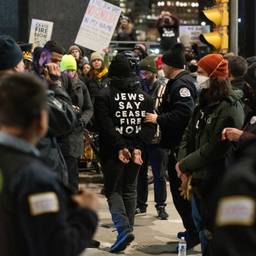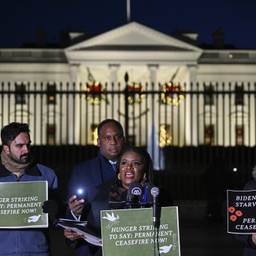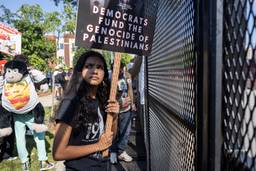The Christmas Truce of 1914 and the Demand for a Cease-Fire in Gaza
The World War I phenomenon should remind us of the urgency to end the mass killings—and to help us realize that a cease-fire to stop the violence is within reach.
Phyllis Bennis

Around the world and in unprecedented numbers across the United States, people of conscience are demanding an immediate end to the unfathomable horror escalating by the hour in Gaza. In the streets, in train stations, on bridges, outside the White House and Congress, on social media, on the phone — doing everything we can to demand a cease-fire.
Protests are everywhere, and every day. On Tuesday, the directors of more than 80 leading social justice organizations (including Alex Han of In These Times) were arrested after refusing to move from the Capitol Rotunda. Before that, Jewish elders chanted “Not in our name!” as they chained themselves to the White House fence (police had to use bolt cutters to take them away). Muslim communities mobilized thousands in prayer outside of Congress, students have been walking out of class, there have been sustained and regular Palestinian-led protests, activists with Jewish Voice for Peace occupied Grand Central Station, Liberty Island, and more than 1,000 marched and took over the Manhattan Bridge.
Daily marches, protests, sit-ins in small towns and big cities from coast to coast are happening with such frequency it’s almost impossible to keep track. A cavalcade of public letters, walk-outs, resignations, and acts of resistance from federal workers — from State Department officials to White House interns — all say they can no longer remain silent in the face of U.S. support for Israel’s assault. All are demanding a cease-fire.
The urgency of the moment, the non-stop killing playing out in real time, visible to everyone with a cell phone all around the world, has brought many into political engagement for the first time. More than 19,000 Palestinians have been killed in Gaza, including more than 7,000 children. More than 50,000 others have been wounded, thousands remain missing or under rubble, and more than 85% of Gaza’s entire population has been displaced.
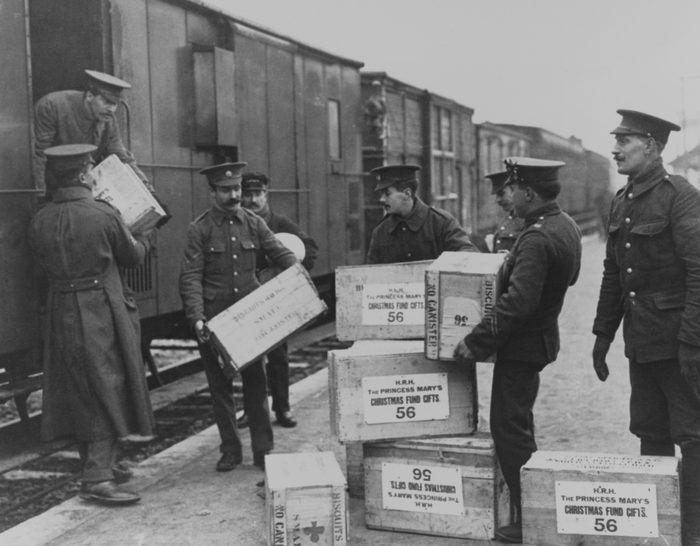
The violence started in early October and now it’s almost Christmas. For many of us who work in policy and international affairs, war and Christmas inevitably leads to the story of the Christmas Truce, an event of more than 100 years ago that bridges history and myth. It was in the first months of World War I along the Western Front, where young French, English and Scottish soldiers faced off against their German counterparts in opposing trenches that were all — on both sides — cold, wet, muddy and miserable.
By Christmas Eve they had been fighting in those trenches for six months, venturing out into the no-man’s land between the two sides only to retrieve the bodies of their fellow soldiers, already dead.
As Christmas approached, some of the soldiers on both sides received gifts from families at home and from others. And on Christmas Eve, according to British historian Simon Jones, German soldiers who had received small holiday trees lit candles on their branches, and raised them up to the edge of the trenches, knowing their enemies in trenches — often just yards away — would see them. Soldiers on both sides started singing carols, and it turned out that Silent Night was familiar in both languages.
Then, small groups of soldiers from each side slowly emerged from their trenches. They met up in the no-man’s land and used the bits they knew of each other’s languages to greet one another. They exchanged small gifts — tobacco and buttons from their uniform jackets. No one had planned for this, it was as if, somehow, Christmas interrupted the warring madness, the violence, at least for a moment.
At one point, a soccer ball appeared, and a friendly game ensued.
“In places, the Germans put up boards on the trenches reading ‘Merry Christmas’ or ‘You no fight, we no fight.’ Officers told their men not to shoot unless it was absolutely necessary and once one side ceased fire, the other followed,” according to Jones. “The quiet was described by an officer as unfamiliar: ‘The silence seemed extraordinary after the usual din. From all sides birds seem to arrive, and we hardly ever see a bird generally.’”
It was indeed a Christmas truce. It mostly ended the next day, though in some areas along the Western Front the truce lasted for many days. In some areas, soldiers on both sides just stopped fighting, ignoring their commanders’ orders to return to the trenches and resume shooting at each other.
Of course there are enormous differences between the battles of World War I and the Israeli assault on Gaza underway today. The Christmas Truce of 1914 stopped — at least momentarily — a war between two formal armies, more or less evenly matched, fighting on behalf of powerful European colonial states, also more or less evenly matched. Where the armies fought in their trenches, it was soldiers who died — few civilians were anywhere nearby.
What is underway in Gaza today is a war of colonization, ethnic cleansing and genocide. It pits one of the strongest, most advanced military forces in the world, replete with tanks, drones, warplanes and more, as well as its own nuclear weapons arsenal and the backing of the most powerful military in the history of the world, against a civilian population of slightly more 2.3 million people — women, men, children, babies, elders — and a small insurgency.
The population in Gaza, 70% of them refugees for generations, had been living for 17 years under an Israeli siege that denied the occupied population access to sufficient water, electricity, food, fuel or medicine. That pre-October 7 siege was severe enough that according to a study that analyzed data from 2011 to 2023, 20% of all children in Gaza were stunted by the time they were two years old. The impoverished and besieged population had endured five separate Israeli military assaults since 2008-09, leaving thousands of civilians killed. The United Nations, in 2018, declared that Gaza, “with an economy in free fall, 70% youth unemployment, widely contaminated drinking water, and a collapsed health care system,” had become “unlivable.” Before October 7.
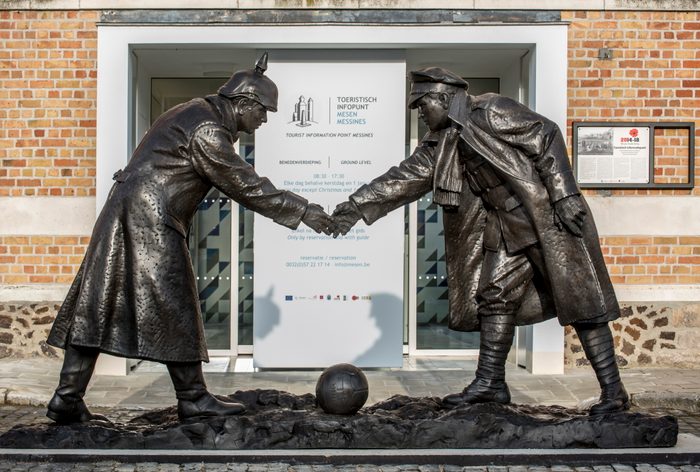
This current one-sided battle in Israel’s long campaign of apartheid and ethnic cleansing against Palestinians was justified by the Israeli and U.S. governments and pro-war advocates as an outpouring of vengeance following the harrowing October 7 attack by Gaza militants. Since those first days, however, it has been much more clearly identified as the continuation — in its most brutal form since 1948 — of Israel’s long war of colonial settlement, displacement and now genocide.
The relevance of the Christmas Truce of 1914 is not about the troops on both sides laying down arms — this is, again, not a war between armies but a military assault on an entire population. The relevance of the Christmas Truce is to remind the rest of us — especially those of us in the United States whose government holds the ultimate power to bring a halt to the Israeli onslaught — of the urgency of a cease-fire to end this horror, and of the realization that it can be done. All you have to do is stop killing people — and it can start with ending Washington’s flow of bombs, planes, drones and guns to the Israeli military.
The Christmas Truce reminds us that when virtually the whole world — almost all people, including the families of the Israeli hostages, along with most governments and every component of the United Nations except the one where Washington wields a veto — says that this war should end and that we need a cease-fire now, that we can make it happen. A small number of people — the extremist Israeli government and its military, the top echelons of the Biden administration and Congress, and vanishingly few others on a global scale — are forcing this slaughter to continue. We can stop it.
A cease-fire can stop the killing. And even when powerful people say the war must continue, that the killing must go on, we know they are wrong. A cease-fire can stop it — and virtually the whole world is on our side. We need a cease-fire now.
Phyllis Bennis is a fellow of the Institute for Policy Studies and serves as international adviser for Jewish Voice for Peace. She is the author of the new book Understanding Palestine & Israel, from Interlink.

